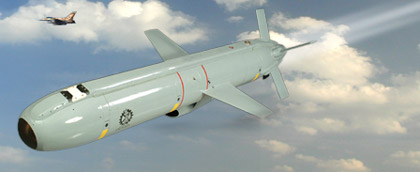For over 20 years Delilah was officially defined as a ‘Suppression of Enemy Air Defense (SEAD) powered decoy, but behind the curtain of secrecy, the Israel Air Force and IMI developed an innovative and unique weapon, that has served the IAF well in the past 20 years.
Originally, Delilah and Samson were developed for the IAF as part of an IMI family of SEAD decoys. However, while Samson continued to evolve as a decoy, that became a successful export product, Delilah disappeared from the ‘radar screens’ and kept a very low profile, becoming one of the air force’s top secret programs. Through its transformation, the decoy evolved into a ‘loitering precision attack weapon’, combining the capabilities of an unmanned aerial vehicle and guided missile, capable of attacking enemy targets with unprecedented precision, agility and persistence.
The weapon’s imaging sensors, smart mission-control and two-way datalink, enable ‘human in the loop’ control which, coupled with extended loitering capability, offering Delilah unprecedented combat capabilities. The weapon can be used to accurately and selectively attack a target at it’s weakest points, for example, targeting a protected command center. In this mode, Delilah can be aimed to strike a specific part of the structure, or disable a vital communications link, without destroying the entire target. The weapon’s loitering capability proves an essential feature, when targets are hidden, concealed, or difficult to identify on the first pass, or if the conditions do not match prior assessment. Under such conditions Delilah is commanded to ‘go around’, wait for better conditions or strike the target from a different angle.
Since Delilah entered service with the IAF in the early 1990s, the weapon went through periodical evolution primarily through Block upgrades. The different missiles may look the same, but their capabilities have significantly been improved over the years. The first production models of the Delilah were integrated only in the Israeli F-4E. It was later introduced to the improved Phantom-2000, F-16C/D and, most lately to F-16I (Israeli Block 52) models. Delilah is currently being evaluated by a number of foreign navies, for use as land attack and anti-ship weapon, carried by naval helicopters.
“Delilah is our ‘flagship of weapons’, the most advanced ground attack weapon the IAF has” says Lt. Colonel Gil, head of ordnance branch in the Air Force’s Weapon Systems Division. Primary use of this weapon is the hunting for targets, such as surface missiles and launchers, rocket launching sites, and surface-to-air weapons. Over the years we also introduced an anti-structure warhead to improve our effectiveness against fortified and urban targets.” During the 2nd Lebanon War the air force used ordnance, representing almost every type of weapon in its arsenal. Delilah missiles were also used, hunting of Hezbollah supply trucks. The missiles tracked vehicles carrying rocket loads, crossing from Syria and destroyed them inside Lebanon.” Lt. Col. G admits Delilah is an expensive weapon that cannot be commonly employed, but only selectively, when the target ‘value’ justifies the cost. The IAF continues to evolve the system, into future weapons that will continue and expand the Delilah concept and its capabilities. Furthermore, the IAF recently upgraded the weapon simulator of the Delilah, to reflect the latest capabilities of the weapon.

















